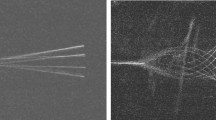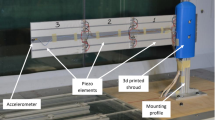Summary
The application of the line-solution technique to the analysis of uniformly loaded cantilever plates is described in this paper. In this method, the two-dimensional partial differential equation of plate theory is reduced to a set of ordinary linear differential equations by replacing the derivatives in one direction by their finite-difference equivalents. The resulting equations are solved numerically by the matrix-progression technique.
Three different approaches are suggested for the elimination of the corner forces which arise as a result of using Kirchhoff's boundary conditions. Numerical results are presented and compared with those of previous theoretical and experimental investigations.
Similar content being viewed by others
References
MacGregor, C. W., Mech. Engng 57 (1935) 225.
Jaramillo, T. J., J. Appl. Mech., Trans. ASME 72 (1950) 67.
Holl, D. L., J. Appl. Mech., Trans. ASME 59 (1937) 8.
Nash, W. A., J. Appl. Mech., Trans. ASME 74 (1952) 33.
Barton, M. V., Finite Difference Equations for the Analysis of Thin Rectangular Plates with Combinations of Fixed and Free Edges, Defence Research Laboratory Rep. No. 175, University of Texas, Austin, TEXAS Aug. 1948.
Livesley, R. K. and P. C. Birchall, Analysis of a Loaded Cantilever Plate by Finite Difference Methods, R.A.E. Tech. Note T.N. M.S. 26, June 1956.
Leissa, A. W. and F. W. Niedenfuhr, J. Aero. Sci. 29 (1962) 162.
Sechler, E. E., M. L. Williams and Y. C. Fung, An Initial Approach to the Overall Structural Problems of Swept Wings under Static Loads, I.A.S. Preprint No. 257, Dec. 1949.
Reissner, E. and M. Stein, Torsion and Transverse Bending of Cantilever Plates, N.A.C.A. Tech. Note. 2369, June 1951.
Morley, L. S. D., The approximate Solution of Plate Problems, Proc. 9th Int. Congr. Appl. Mech., p. 22, Brussels 1957.
Frolov, V. M., Application of a Method of Correcting Functions in the Analysis of Deformations of Cantilever Plates, Vypusk No. 705, Trudy Tsentral'nogo Aero-Gidrodinamicheskogo Instituta, Oborongiz, Moscow 1957 (in Russian).
Coull, A., J. Appl. Mech. 32 Ser. E (1965) 67.
Coull, A., Aircraft Engng 37 (1965) 182.
Zienkiewicz, O. C. and Y. K. Cheung, Proc. I.C.E. 28 (1964) 471.
MacNeal, R. H., J. Appl. Mech., Trans. ASME 73 (1951) 59.
Dalley, J. W., Experimental Values of Deflections, Stresses, and Influence Coefficients for a Thin Square Plate Along One Edge, Defence Research Laboratory Report No. 189, University of Texas, Austin, TEXAS Nov. 1949.
Palmer, P. J., Aircraft Engng 29 (1957) 377.
Hartree, D. R. and J. R. Womersley, Proc. Roy. Soc. A 161 (1937) 353.
Tottenham, H., The Matrix-Progression Method in Structural Analysis, Introduction to Structural Problems in Nuclear Reactor Engineering, Ed. Rydzewski, Pergamon Press, Oxford 1962.
Author information
Authors and Affiliations
Rights and permissions
About this article
Cite this article
Coull, A., Rao, K.S. Analysis of cantilever plates by the line-solution technique. Appl. Sci. Res. 18, 309–321 (1968). https://doi.org/10.1007/BF00382355
Received:
Issue Date:
DOI: https://doi.org/10.1007/BF00382355




